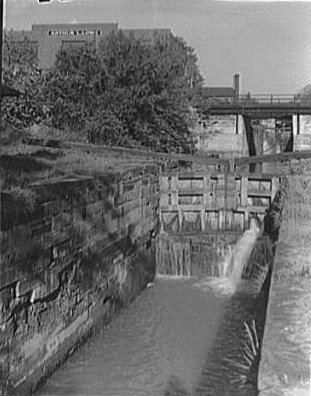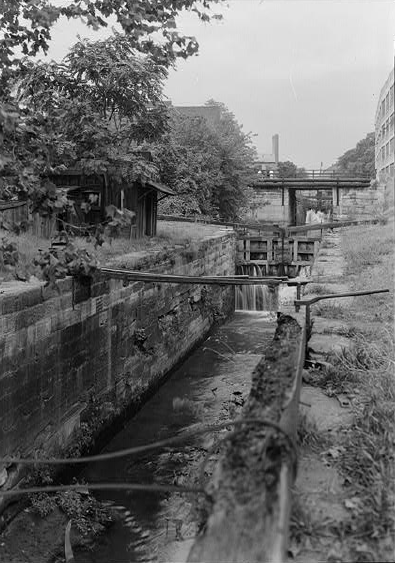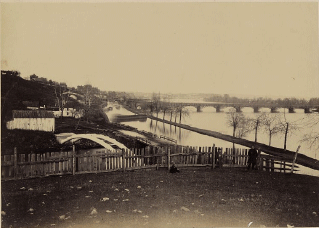What `Watergate' meant, before it meant scandal HOME
|
A lovely old canal almost lost to the ages has now become unforgettable part of history Thirty years ago today, a man many regard as the last progressive president resigned from the White House after a scandal the media called Watergate.
To this day, when anyone wonders why American political scandals end in `gate,' the answer is usually attributed to the first big scandal, named for the Watergate Hotel. Burglars working on behalf of Richard Nixon's re-election broke into Democratic Party offices there, a small crime that triggered the investigation into an enormous political crime that would bring down an entire administration. A few may wonder where the Watergate Hotel got its name. I stumbled across it, not literally, one day in 1969 -- three years before the break-in, and shortly after I had moved to the Washington area to work at the Pentagon.
Photographer: Albert Burns, Oct 1935. LOCK #1 Looking west to 29th st. HABS I had joined the Army the year before -- Regular Army, thank you -- and was strolling along the tow path of the old Chesapeake and Ohio Canal one Saturday afternoon. It's a lovely old canal almost lost to the ages half a century ago when local road planners wanted to pave it over and make it a freeway. Had they done so, they would have wiped out nearly two centuries worth of American history. In 1754, George Washington had envisioned the C&O Canal as a way to link the Chesapeake Bay to the Midwest. The plan was to build a canal from Georgetown on the Potomac River to Pittsburgh on the Ohio River, and on to the heartland via the Mississippi. The canal would begin just about where Rock Creek empties into the Potomac River, with a canal and locks system paralleling the Potomac River valley. President John Quincy Adams broke ground for the canal in 1828. Builders got as far as Cumberland, Md., 184.5 miles upstream. It was profitable for a time, but the Baltimore and Ohio railroad, roughly paralleling the canal, ultimately doomed it. Floods took their toll as well, though the railroad continued operating parts of the C&O canal until 1924. The government bought it in 1938, and by the early 1950s had hatched the parkway plan. Then Supreme Court Justice William O. Douglas, an outdoorsman and historian, went to work. He recruited a party of editorial writers from The Washington Post, which had backed the plan to pave over the canal, and led them on a hike along the entire length of the C&O canal. By the end of the trip the writers had changed their minds, and eventually Congress preserved it as a National Historical Park. Without that designation, the canal would have disappeared, and so might the little-known area around the canal's Milepost 0. When we first saw it that afternoon in 1969, it was little more than an old jumble of stones and timbers. But it was, we later learned, the water gate -- the last lock, where water coming downstream along the C&O canal could empty into the Potomac. It was the place where canal boats could move on and off the Potomac River. With the water gate closed and the channel filling with water, they could begin the long process of locking up through the C&O. When a new complex with a hotel, condominiums, offices, restaurants and shops was built just across Rock Creek Parkway, it took its name from that old water gate -- and became the Watergate. |

Photographer: Theodore Horydczak, Georgetown Canals ca. 1920
I had just gotten out of the Army in the spring of 1972 and was resuming my newspapering career in Washington. My old newspaper, the Greensboro Daily News, needed someone for its Washington bureau. North Carolina's senior senator, a scholarly conservative named Sam Ervin, had been asked by his Senate colleagues to look into Watergate.
Ervin, a Morganton Democrat, wasn't thrilled about it. There were other constitutional issues he was interested in, but he took the job -- and over the next year or so laid bare the secrets that the Nixon administration had hoped to keep under wraps. His Senate Select Committee on Presidential Campaign Activities held a riveting series of televised hearings exposing the White House's attempts to cover up President Nixon's involvement in a number of illegal campaign activities. As we now know from the secret tape recordings that Nixon had ordered made of White House conversations, he was in the cover-up from the start. And what we also know now, that we didn't quite know then, is that the news media had somewhat less to do with exposing the wrongdoing than previously thought. The latest issue of American Journalism Review quotes Stanley Kutler, regarded as the most authoritative writer of Watergate histories, as pouring cold water on the myth of an independent press bringing down a president. "As more documentary materials are released, the media's role in uncovering Watergate diminishes in scope and importance. ... media revelations of crimes and political misdeeds repeated what was already known to properly constituted investigative authorities. In short, carefully timed leaks, not media investigations, provided the first news of Watergate," he wrote. Kutler's research indicates that law enforcement agencies were already aware of information that the news media were reporting, suggesting that reporters not only benefited from leaks but also exaggerated their roles in unraveling the scandal. He also concludes that Nixon would have been forced out even if the news media had not been aggressive in its reporting. Everyone has his own heroes in this sordid scandal. I'm an admirer of Sam Ervin and Howard Baker, the Southerners who made sure the Senate investigation examined not only what happened but also what the president knew and when he knew it. And I'm still a fan of Republican Caldwell Butler of Virginia and Jamie Mann of South Carolina, whose initial doubts on the House Judiciary Committee turned into important votes for articles of impeachment of President Nixon. He resigned before the full House began its impeachment proceedings. When the Watergate inquiry began, I had my own doubts. Richard Nixon had been my commander in chief. I had attended a White House function a time or two in uniform. I couldn't imagine that he'd be guilty of such notorious political crimes. But then, I couldn't have imagined in 1969 that a pile of rocks and timbers in a leafy Washington creek would be the namesake for the most famous political scandal in our history, either.
Jack Betts, associate editor, Charlotte Observer August 8, 2004
. |

